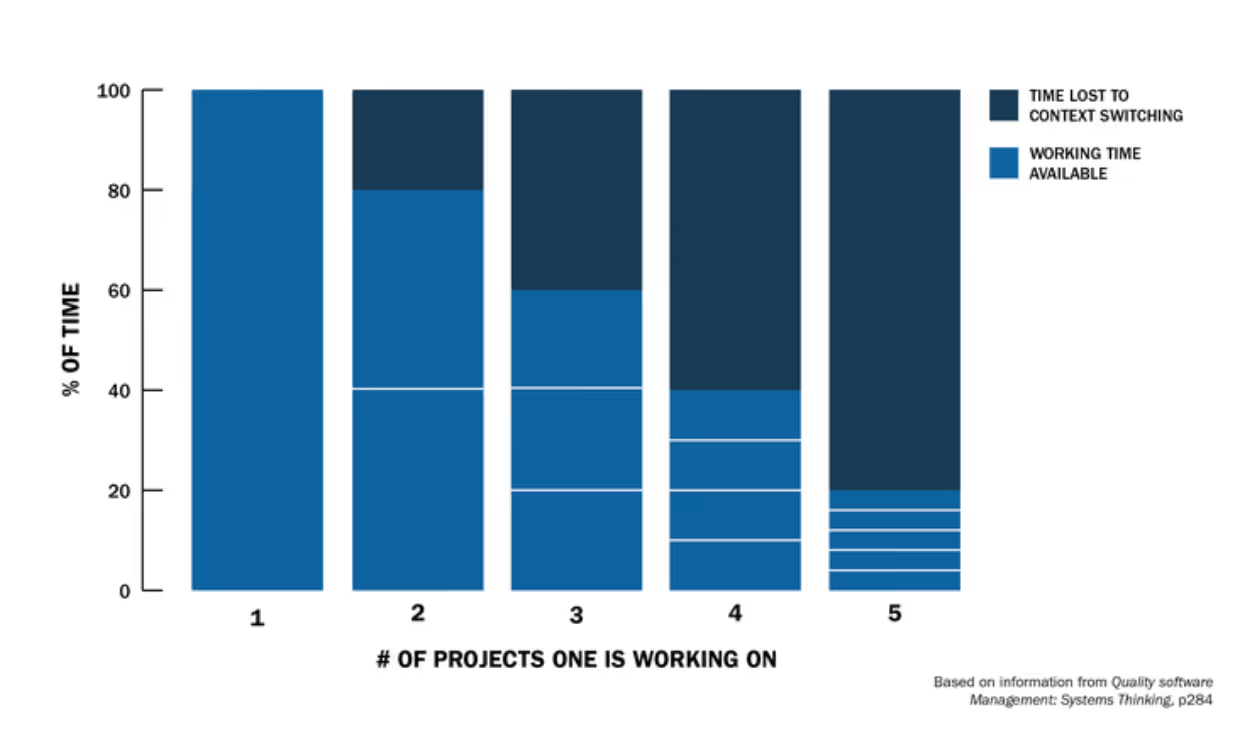There are so many tools and processes that are wolves in sheep’s clothing — those that actually steal your time rather than give it back as promised. One of those time thieves is context switching, and it’s something most knowledge workers deal with on a daily basis.
How can you tell if your team is trapped in a context-switching spiral, what are the effects, and what are the consequences? Read on to learn more about this time thief and what you can do to combat it.
What is context switching?
Context switching is what happens to your brain when you jump between tasks, tools, or projects. It’s the space between states of mind when you have one foot in the previous task and one in the next. The feeling is a little bit like those two minutes between back-to-back meetings when you’re racing to remember what your next meeting is about before it begins. Needless to say, it’s not the most zen or productive way to work.
Unfortunately, it’s a sad reality. A recent study of 20 teams across three Fortune 500 companies found that “workers toggled roughly 1,200 times each day.” That staggering statistic adds up to four hours each week, or four weeks in a year lost simply reorienting yourself.
Why does it happen? Because we’ve created an environment that allows context switching to be the norm. We have endless tools, each with its own platform and experience, and the information we need to do our jobs throughout the day is spread across each of these tools. This means we become our own little search parties hundreds of times daily. There’s also a perceived pressure to respond to notifications immediately, and those are never in short supply. Every ping is likely to take you out of whatever deep work you were doing and into the world of the message, only to re-enter your task, trying to remember where you left off.
When we are constantly taken out of our flow state, we feel like all we have to show for a full day of work is a handful of meetings and a worn-out mind.
The effects of context switching
The most obvious effect that context switching has is the interruption of flow. Flow state is the optimal way of being engaged in deep work — each idea flows, every decision makes sense, you’re focused, and, according to the Harvard Business Review, performance goes through the roof when in this state.
But people take almost 10 minutes to get back into a flow state when context-switching between apps. Considering how many times per day the average worker is flipping between apps, pages, projects, and chats, the minutes add up.
Another effect of context switching is one we don’t see during multitasking when projects are completed simultaneously: slower, less efficient work. While the jury’s still out on the benefits of multitasking, multitaskers at least know they’ve got two or more projects on the go at once, and they’re in control of that.
One of the negative impacts of context switching is the near-surprise element — you’re working on one thing, and suddenly you need to leave that task to find a piece of information or to answer a message. This results in slower, more incremental work on each task combined with cognitive downtime in between, meaning results are slower and less efficient than they could be.
Context switching is going to cost you
The impact of those effects will cost any business in three major ways: time, quality, and money.
Time
We’ve already outlined how much of each day the average worker spends toggling between tasks and platforms and the overall effect that has on productivity. According to the Software Engineering Institute at Carnegie Mellon University, the more projects you’re working on at once, the greater the percentage of time that’s lost to context switching. When you get up to five projects, the average worker is only expending 20% of their energy on the actual work, with the other 80% falling between the cracks.

Quality
You might think that even if less time is dedicated to the work itself, and the results are a bit slower, the outcomes remain the same — not so. The decreased cognitive function that goes hand in hand with context switching results in a lower quality of work. Carnegie Mellon notes that increased buggy code and missed tasks become prevalent among software engineers. And part of that dip in quality comes from an inability of team members to get on the same page during a day of flipping between tasks, tools, and meetings. According to a Workgeist Report, “nearly two-thirds of people report missing opportunities to collaborate in the modern workplace.”
Money
With up to a 40% decrease in productivity, the cost of context switching certainly shows up on the bottom line. A team member juggling five projects and only getting 20% of work done a day instead of 80%? You do the math. According to Loom, “lost productivity due to context switching costs the global economy an estimated $450 Billion annually.”
The overall business impact of context switching
Losing money, time, and sacrificing quality, all spell disaster for businesses working in challenging market conditions with ever-changing goalposts. The business impact of context switching could quite literally mean the difference between a quarter in the red and one in the black.
Of course, the less visible extension of these effects themselves is the impact this loss of time, focus, and efficiency has on employees’ mindsets. When all your best working moments are interrupted, when projects drag on past their expiration date, motivation takes a sharp downturn, and job satisfaction follows.
A team that’s stretched for time and budget, likely taking on more work and wearing more hats than ever before, is the most susceptible to the trap of context switching. It requires intention to avoid this trap.
How to avoid the pitfalls
“Do more with less” is table stakes now, but what does it mean to actually enable that mindset?
The effects of a thinly spread workforce, seeking resources that are scattered far and wide and out of context of what they’re doing—highlight the need for implementing tools like an LMS for sales training and revenue operations software to centralize learning and reduce inefficiencies.
If you were always losing your keys — we’re talking spending weeks of each year looking for them, always being late — you’d do something about it, right? If your team is inundated with tools and processes that consistently take them out of the flow of work, find a tool that does the opposite.
Spekit is the number one-ranked just-in-time learning platform that surfaces learning directly in the tools your team uses every day. It closes that gap between learning and doing and eliminates needless context switching that loses you time, money, and quality work.







